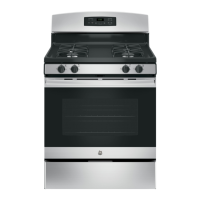24 49-2000316 Rev. 3
Problem
Possible Cause What To Do
My new oven doesn't
cook like my old one.
Is something wrong
with the temperature
settings?
Your new oven has a different cooking system
from your old oven and therefore may cook
differently than your old oven.
For the first few uses, follow your recipe times and
temperatures carefully and use rack positions recommended in
the Cooking Guide. If you still think your new oven is too hot or
too cold, you can adjust the temperature yourself to meet your
specific cooking preference. See the Oven Controls section.
Food does not bake
properly
Oven controls improperly set. See the Cooking Modes section.
Rack position is incorrect or rack is not level. See the Cooking Modes section and Cooking Guide.
Incorrect cookware or cookware of improper
size being used.
See the Cookware section.
Oven temperature needs adjustment. See the Oven Controls section.
Food does not broil
properly
Oven controls improperly set. Make sure you select the appropriate broil mode.
Improper rack position being used. See Cooking Guide for rack location suggestions.
Cookware not suited for broiling. 8VHDSDQVSHFLILFDOO\GHVLJQHGIRUEURLOLQJ
Aluminum foil on the broil pan has not been
fitted properly or slit to drain grease.
If using aluminum foil on broil pan, wrap tightly and add slits
conforming to those in the pan to allow grease to drain.
Oven temperature
too hot or too cold
Oven temperature needs adjustment. See the Oven Controls section.
Oven and/or display
appears not to work
A fuse in your home may be blown or the circuit
breaker tripped.
Replace the fuse or reset the circuit breaker.
Oven controls improperly set. 6HHWKH8VLQJWKH2YHQVHFWLRQ
A single bracket "]" shows in the display. 3UHVVBake and Broil pads at the same time and hold for
WKUHHVHFRQGV6)ZLOODSSHDULQKHGLVSOD\3UHVVWKHSet
Clock pad or the Cook Time pad until "On" appears in the
display and then press Start. The display will change from a
single bracket "]" to the time of day.
The clock is turned off. See the Oven Controls or Special Features section.
“Crackling” or
“popping” sound
This is the sound of the metal heating and cooling
during both the cooking and cleaning functions.
This is normal.
Why is my range
making a "clicking"
noise when using
my oven?
Your range has been designed to maintain a
tighter control over your oven's temperature.
You may hear your oven's heating elements
"click" on and off more frequently than in older
ovens to achieve better results during baking,
broiling, and self-clean cycles.
This is normal.
Clock and timer do
not work
A fuse in your home may be blown or the circuit
breaker tripped.
Replace the fuse or reset the circuit breaker.
Sometimes the oven
takes longer to
preheat to the same
temperature
&RRNZDUHIRRGDQGRUQXPEHURIUDFNVLQ
oven.
Cookware, food, and racks in the oven will cause
differences in preheat times. Remove excess items to
reduce preheat time.
Oven light does not
work
Light bulb is loose or defective. Tighten or replace bulb. See the Maintenance section for
instructions on how to replace the bulb.
Oven will not self-
clean
The temperature is too high to set a self-clean
operation.
Allow the oven to cool and reset the controls.
Oven controls improperly set. See the Care and Cleaning section.
Excessive smoking
during clean cycle
Excessive soil or grease. Turn the Oven Temperature Knob to OFF. Wait until the
Oven cools below the unlocking temperature. Open the
windows to rid the room of smoke. Wipe up the excess soil
and reset the clean cycle.
Oven not clean after
a clean cycle
Oven controls improperly set. See the Care and Cleaning section.
Oven was heavily soiled. Clean up heavy spillovers before starting the clean cycle.
Heavily soiled ovens may need to self-clean again.
Strong “burning” or
“oily” odor emitting
from the vent
This is normal in a new oven and will disappear
in time.
To speed the process, set a self-clean cycle. See the Care
and Cleaning section. This is temporary.
Troubleshooting Tips ... Before you call for service
Save time and money! Review the charts on the following pages first and you may not need to call for service.
TROUBLESHOOTING TIPS

